some pieces in the menzbieri / gustavi puzzle?
Introduction
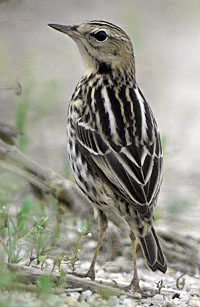
Despite the publication of the excellent Pipits and Wagtails (Alstrom and Mild, 2003), there remains inadequate information on the distribution and identification of (non-singing) Pechora Pipit Anthus gustavi to subspecies. Although nominate gustavi is considered reasonably well known (both on its breeding grounds and as a vagrant to both Western Europe and North America), the extremely similar subspecies menzbieri is not. Long of interest to ornithologists and birders in South Korea (where both nominate gustavi and menzbieri are considered to occur), the need for field identification criteria to separate the two seems recently to have taken on increased importance, as differences in song and perhaps some other vocalizations have led Alstrom and Mild (2003) to state that the two taxa are "perhaps best treated as separate species". Such a treatment would presumably then necessitate a review of all records of ’Pechora Pipit’ from outside of the breeding areas. This note therefore describes the status of Pechora Pipit in South Korea, and highlights some possible identification criteria for the two taxa, based on migration strategy, structure, plumage (supported by a series of images), and calls. It is written fully in the understanding that criteria for separating menzbieri and gustavi in the field are still in their very earliest stages, and that such criteria will only be satisfactorily refined through detailed studies of individuals within known and exclusive breeding areas, rather than through observations of migrants (as here) or vagrants.
As always we would very much welcome discussion and informed comment, especially from those with experience of the species, leading to correction and an improvement in our understanding.
Distribution of Pechora Pipit
According to Alstrom and Mild (2003), widely acknowledged as the most authoritative published source on this and other Palerarctic pipit species, the Pechora Pipit breeds largely in a narrow belt across northern Siberia (gustavi), with disjunct and isolated populations nesting well to the south (menzbieri), mostly concentrated along the lower stretches of the Amur River. Its wintering range is imperfectly known, but includes the Philippines (both subspecies), northern Borneo and Wallacea. It has been recorded as a vagrant to several European countries (presumably mostly or entirely gustavi?), and Alaska.
The Pechora Pipit is very largely or entirely a migrant through the Korean peninsula. Tomek (2002) cites only 7 records of Pechora Pipit in North Korea, but based on measurements she considers that these include both nominate gustavi and the shorter-winged menzbieri. One of the specimens of the supposed menzbieri was collected in late June, suggesting the possibility of occasional breeding in northwestern Korea. In this respect, it is important to note that Alstrom and Mild (2003) record that breeding has also been suspected in both Liaoning and Hebei Provinces, only a few hundred kilometers further northwest.
Status and Timing of Migration through South Korea
In South Korea it appears to be entirely a passage migrant: uncommon in spring, but relatively numerous in autumn. Although data are sparse (as few observers are familiar with the calls), personal observations since 2000 especially suggests that in both spring and autumn there are two waves of migration, with the second wave invariably larger than the first.
In spring the vast majority of Pechora are recorded on the west coast, especially on offshore islands. First arrivals tend to occur in the last week of April (e.g. first records on April 30, 2002; April 24, 2003; and April 27, 2004), coinciding with heavy migration of both Olive-backed A. hodgsoni and to a lesser extent Red-throated Pipits A. cervinus. These earlier migrants, trailing off by the second week of May, are followed by what appears to be a second slightly larger peak in the last third of May, falling away rapidly into early June (latest personal observation being of 3 on June 1, 2004, but coverage very limited at this time) - rather later than other ’small’ pipits.
In autumn, they appear to be the first ’small’ pipit to arrive on migration in South Korea, preceding for example the much commoner Olive-backed by one or two weeks, and Red-throated Pipit by two or three weeks. The earliest personal records have been in the last week of August (i.e. 4 on August 29, 2002 and one on August 29, 2003), with numbers increasing slowly to a small peak in the first third of September, followed by apparently reduced numbers, and then a much larger second wave of migrants in the last week of September and the first two weeks of October. Although Pechora are regular at least on both the south and west coasts at this time (and presumably on the east coast and inland too, though personal observations there at this time have been extremely limited), highest spot counts during this second period in e.g. 2003 were in rice-fields and salt-pans on the west coast, with for example 20 at one site on September 29th and 30 at another on September 30th in the Saemangeum area, and at least 10 at Seosan also on 30th. Often mixed in with or loosely associating with flocks of Red-throated Pipit, these later birds are widespread in many areas of extensive rice-field until mid-October, with the latest individual logged in 2003 on Socheong Island, on October 25th.
Identification of Pechora Pipit
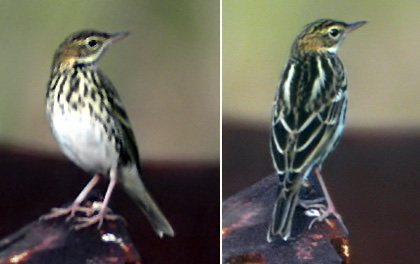
Considering the pipit taxa as a whole, Pechora Pipit (containing both gustavi and menzbieri) is fairly easy to separate from other species of ’small’ pipit, as it has distinct vocalizations (see below), and a distinctive structure and plumage. Even in flight, in many the bill looks rather heavy (and is often held pointed slightly downwards), the head rounded and heavy, the chest deep, and the tail rather short (making the bird appear somewhat front-heavy), while the wings also appear to have rather broad wing-bases. The overall impression of birds in sustained flight therefore can often recall e.g. Grey-streaked Flycatcher Muscicapa griseisticta. In addition, the wings in some appear vaguely translucent, and at such times one or more rarely both wing bars show fairly obviously from below, an effect not yet noted in e.g. Red-throated Pipit. Although more often seen in flight than on the ground, occasional individuals do show well. At such times, Pechora look rather powerful, deep-chested and strong-billed (often with the bill held slightly upward), and with powerful legs. The diagnostic primary projection beyond the longest tertial is usually apparent on even fairly brief views. The plumage is also rather striking.
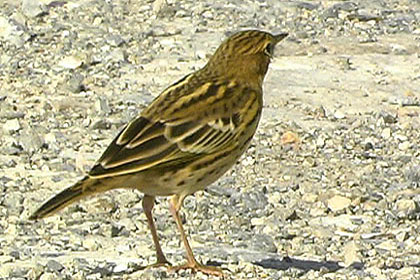
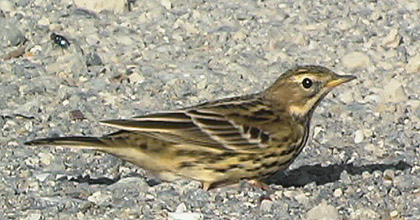
From these two views note the lack of primary projection and the rather plainer upperparts than shown by Pechora. It lacks the contrastingly warmer nape sides, has a less strongly patterned mantle and a concolorous rump. In addition, although the lores are unmarked, the supercilium is fairly pronounced.
Apparently not possible to sex in the field, and very difficult to age after the juvenile molt (Alstrom and Mild, 2003), Pechora Pipit shows a distinctive combination of heavily marked upperparts, with pale "braces" contrasting with a largely darker mantle; a boldly marked breast, with variably buffy wash, again contrasting with a whiter belly; and two strong whitish wingbars (formed by broad white tips to the dark-centred median and greater coverts). This rather contrasting appearance is typically set off by a very warm buff, even light ginger, wash across the sides of the nape - the warmest color visible on the majority of individuals.
On the best views, further subtle differences from non-breeding or first winter Red-throated Pipit (the only likely confusion species for experienced observers) include: a brightish pink base to the lower mandible (typically rather yellowish in Red-throated) and more silvery-pink tones to the legs (occasionally redder in tone); a plainer head pattern overall, often lacking an obvious supercilium; a dark shadow or spot/line on the lores and a black line cut through the rear of the eye-ring; a more clearly streaked crown, and a weakly streaked or mottled edge to the rear of the ear coverts; often brownish tips to some of the greater coverts; contrastingly brownish feathering on the rear of the tibia, often extending up in a wedge towards the rear flanks; and rather narrow and off-white or buffish edges to the closed tail, often with rather pointed and jagged looking rectrices (very subtle features not easy to determine in flight or brief views!).
gustavi or menzbieri?
As for field differences between gustavi and menzbieri, there are very few clues available in the literature, and what information there is seems to contain some element of contradiction. Alstrom and Mild (2003), reveal that the songs appear "markedly different" (but with the caveat that more research is still required to confirm that this difference is not a product of individual or geographical variation), and that perhaps menzbieri also gives a soft "sit" alarm call at the nest, suspected different to the equivalent call given by gustavi.
In addition, they state, based on exhaustive research, that
menzbieri is "distinctly smaller than gustavi, with only slight overlap in wing measurements when the sexes are completely separated" (males being larger than females);
"In direct comparison with gustavi, menzbieri is less rufous, more greenish-grey above with slightly broader dark streaks on crown and mantle - accordingly it appears darker above".
Despite their potential significance it is hard to interpret how either of such criteria can be used in the field with any confidence. Although a "large-looking" migrant Pechora can therefore be assumed to be more likely a gustavi than a menzbieri, correctly gauging the size and structure of lone birds is often extremely difficult. In addition, as the sexes are "indistinguishable by plumage" (Alstrom and Mild, 2003), how can large male menzbieri be separated from small female gustavi? Even in the hand, it appears, many birds’ measurements might fall in the range of overlap. As for darkness of the upperparts, the same authors also state that this feature is influenced by bleach and wear.
Predictably, in trying to separate gustavi and menzbieri in field conditions there are further multiple problems. Pechora Pipit is often extremely skulking, usually found singly (preventing "direct comparison of plumage tones"), and even where common on migration, it tends not to form tight flocks, instead forming loose groups. Its cryptic patterning, as with e.g. some snipe species, means often there is too much to look at and note in typically short views, and differences between individuals often seem to lie more in overall impression than due to diagnostic differences in the patterning of certain feather tracts. Beyond these practical problems in the field, there are likely also some problems even when comparing individuals in the specimen record. Reading Alstrom and Mild (2003) closely, it seems that there must be at least a reasonable likelihood that some specimens are incorrectly labeled, suggesting the possibility that the range of overlap in measurements might be greater (or perhaps less?) than being suggested.
To quote Alstrom and Mild (2003), who cite Nazarov (1981), "the taxon menzbieri arrives on the breeding grounds from late April to late May, and gustavi passes through that area at the same time". Unless all such birds were in song, how, beyond measurements, were they being identified to subspecies by Nazarov? Presuming that they were mainly identified in the hand and that both taxa were actually occurring together in the breeding range of menzbieri as stated, is it not possible that at least some specimens were identified simply on the basis of measurements (small = menzbieri, large= gustavi), creating bias to discussion on biometrics and subsequently plumage descriptions? In the same way, it is important to note that at least some of the measurements of gustavi Pechora Pipit given in Alstrom and Mild (2003) were not of birds collected in northern breeding areas where menzbieri remains unrecorded. They were collected on migration - not only in China, as clearly indicated, but also in Korea (where both subspecies are considered to occur, though not referred to in the text), and as non-breeding birds in the Philippines. The same also appears to be true of the menzbieri specimens. Allowing for the possibility of variation within nominate gustavi across a very wide breeding range (something suggested by the description of two other subspecies, ’stejnegeri’ and ’commandorensis’ - though neither are recognized by the authors), and even within menzbieri across an imperfectly known range, how precise are the measurements? In addition, how consistent is the presence or absence of plumage differences, necessarily described, it is presumed, largely on comparisons of the same (incorrectly or correctly labeled) specimens?
The sense of confidence in separating many individuals of the two taxa on the basis of measurements alone appears to be even further undermined by Svensson (1992) writing more than a decade earlier, who suggested that the difference in wing length between menzbieri and gustavi was "very slight". Svensson does however add one additional identification feature potentially of use in the field: menzbieri is considered "darker above and deeper yellow-buff below" than gustavi. This criterion is somewhat downplayed by Alstrom and Mild (2003), however, who do not refer to the buffiness of the underparts as a way to separate menzbieri and gustavi, but instead state that bleach and wear not only affect the upperparts, but also the degree of buff on the underparts too.
Conclusions thus far from reading some of the specialist literature:
the two subspecies look very similar;
the largest should be safely identified as gustavi, the smallest are likely to be menzbieri;
menzbieri should appear darker above;
menzbieri might appear buffier below;
menzbieri might show less rufous and more grey-green tones above than gustavi;
menzbieri and gustavi might show some slight differences in vocalizations;
all the criteria need further refinement through the much more thorough description of individuals in song in known breeding areas.
Pieces of a puzzle: Korea
Although differences between menzbieri and gustavi in the field are both minor and perhaps largely untested, observations of migrants in South Korea suggest that there are some subtle differences shown by Pechora Pipits that could be either a product of individual variation or perhaps more likely, of different subspecific origin. There is a tendency, for example, for smaller and duller Pechora to occur early in spring, and for obviously buff-bellied birds to occur early in autumn. There is also a tendency for some of the early spring migrants especially to give calls that recall eastern Zitting Cisticola Cisticola jundicis brunniceps more strongly than e.g. Grey Wagtail Motacilla cinerea. Although many such observations are not well-documented, and lack the support of sonograms and/or specimens, it nonetheless seems important both to note them here and to suggest a possible explanation for them - this in the hope that they might over time be affirmed or rejected by more thorough observations of the taxa on the breeding grounds.
Timing of Migration
Gustavi breeds much further north and west than menzbieri. With such disjunct breeding ranges it might be expected that the taxa would show some difference in migration strategies. In South Korea, most bird migration in spring is concentrated between mid-April and late May. For many species with distinct subspecies there is a fairly strong tendency for more southerly and easterly breeding populations to migrate through South Korea earlier than more northerly and westerly ones. If it is accepted, on the basis of Tomek (2002) at least, that both subspecies of Pechora Pipit do occur in Korea, then this might well be one possible cause for the two waves of migrants recorded here in spring, with the earliest birds occurring in late April and early May, and a second wave occurring in late May. Logic would suggest that the earlier individuals were more likely to refer largely to more southern-nesting menzbieri, and the later individuals largely to northern and western nesting gustavi. That the second wave contains many more individuals than the first wave also seems to support such a supposition, as gustavi, based on its much more extensive range, appears to be rather more numerous overall than menzbieri. Even near Lake Khanka, in the core of its restricted known range, Alstrom and Mild (2003) note that menzbieri is "presumably uncommon on the Chinese side, since we failed to find it there on two visits".
How about the significance of the actual dates of spring Pechora in South Korea? It is worth again considering the observations of Nazarov cited above: "menzbieri arrives on the breeding grounds from late April to late May, and gustavi passes through that area at the same time". The time span described unfortunately covers (almost) the whole migration period of Pechora Pipit through South Korea, but presumably the earliest menzbieri (identified it can be presumed by at least some singing individuals?) are considered to arrive in late April, when the first Pechora are also migrating through South Korea only 1000 km to the southwest. Nominate gustavi, on the other hand, arrive on the Komandorskiye Islands in late May or early June, and "further north" in the second week of June (Alstrom and Mild, 2003). Interestingly too, the same authors report that gustavi also passes through Hebei Province (to the northwest of Korea) mainly in the latter half (third) of May. This later timing of migration of gustavi in Hebei and further north clearly matches the timing of the second wave of Pechora observed in South Korea. Is it not reasonable to consider that many of the records of Pechora in late May in South Korea refer to gustavi?
In autumn, southward migration of different populations of different species through South Korea as elsewhere is less simple to describe, as it is greatly complicated by e.g. molt strategies, and the presence of non-breeders and juveniles. In the case of Pechora Pipit, however, there again appear to be two waves of birds, the first (in late August and early September) much smaller than the second (in late September and early October). According to Alstrom and Mild (2003) gustavi has a complete post-breeding and partial post-juvenile molt, beginning in July and finishing in August to early September. Although information is lacking for menzbieri, such a molt is likely to occur earlier, as the taxon nests significantly to the south, and is therefore presumably able to breed significantly earlier than northernmost gustavi. In addition, the same authors state that the nominate subspecies "leaves the breeding grounds in the Kolyma and Indigirka region in mid-September and the Komandorskiye Islands early in the second-half of September". The appearance of vagrant Pechora Pipit in Western Europe from mid- to late September suggests that a significant number of (presumed) gustavi are undertaking long migrations at this time. The first autumn Pechora Pipit arrive in South Korea in late August, however - significantly earlier than the main departure of nominate gustavi from breeding grounds. Although these could simply be a few very early migrant (south eastern?) gustavi, it is interesting to note that at least in 1994, observations of Pechora at Happy Island and Beidaihe in Hebei Province were made from September 1st nearly every day, but it then "became scarce" in mid-September, with only one more record, that on September 24th, towards the very end of the observers’ stay (Dierschke and Heintzenberg, 1994). This pattern seems to match the pattern of occurrence in South Korea. The sharp increase in numbers in late September in South Korea (also seen in Hebei?), and the occurrence of small numbers of migrants in western Japan at this time (pers. obs.), also in turn seems to tie-in well with the departure of gustavi from northern breeding grounds from mid-September (the distance from westernmost breeding areas to e.g. western Europe being comparable to the distance between northern breeding areas and Korea).
Although not supported by biometric data or by songs, it is very tempting therefore to speculate that the subspecies have subtly different migration strategies, with menzbieri tending to migrate earlier in both spring (last week of April, first week of May) and perhaps autumn (end of August to mid-September), and nominate gustavi migrating through Korea rather later (mid-May to early June and late September to mid-October in spring and autumn respectively). But do earlier and later migrating Pechora Pipits tend to look or sound at all different in the field?
Plumage and structure of early and late migrant Pechora Pipits in South Korea
The vast majority of Pechora Pipits in South Korea are recorded only in flight. Grounded birds tend to be skulking, and occupy a broad range of "open" habitats, most especially arable plots, slopes with dense grass, and around garbage tips on offshore islands, and in very extensive rice-fields on the mainland. Prolonged observation is therefore only possible in a very small number of instances. However, Pechora Pipit in South Korea appear to show rather more variation in plumage than suggested for example by descriptions and images of vagrants occurring in Western Europe (largely or wholly considered to be of the nominate subspecies gustavi). Most especially, early migrants in spring and autumn tend to appear rather dull, lacking in strong contrast on the upperparts (i.e. browner overall [rather than green-grey], with largely brown-tinged and not clean white fringes etc.), with strongest rufous tones towards the rump, and without contrastingly obvious warmth on the nape sides. Especially in autumn at least some early migrants also appear very brown on the upperparts, with a much more extensive buff wash on the underparts than later migrants. Many such early birds in both seasons appear rather smaller-billed too, though this could be more an effect of posture (less confident and more creeping) than actual bill length or depth.
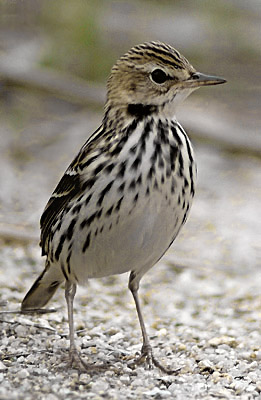
A comparison of three individuals photographed in spring in South Korea reveal many small differences that combined seem to create a rather different impression. The first individual was photographed in dry arable fields on Eocheong Island on May 5th, the second on Hong Island in the far southwest on April 24th, and the third in an area of extensive rice-fields in Seosan on May 30th. Based on a combination of plumage and timing, it seems reasonable to suggest that Individuals One and Two are more likely menzbieri, and that Individual Three is nominate gustavi.
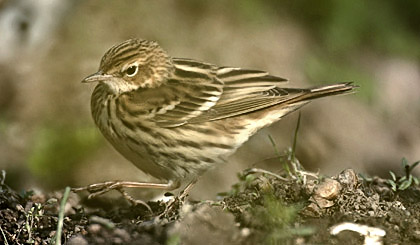
Individual One: May 5th
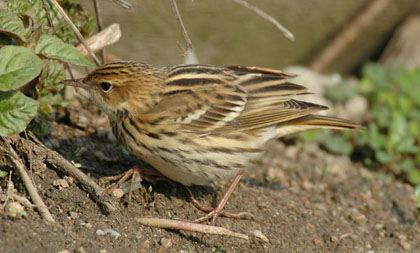

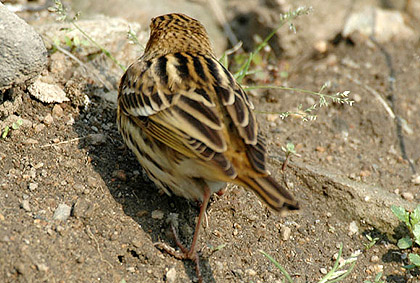
Eocheong Island, © Frederik Willemyns
This rather dull Pechora was photographed in bright sunlight in an area of dry arable plots. When it was accidentally flushed it gave a single weak monosyllabic "chuyt" call. Subsequently feeding silently within a few meters of observers, it apparently often fed by pushing up vegetation, feeding on the underside of leaves (behavior vaguely suggestive of Japanese Wagtail Motacilla grandis).
The series of images reveals a bird that is deeper-chested and stronger-billed than, but still rather close in posture to a Meadow Pipit Anthus pratensis. In overall tone it is rather suggestive of a first winter Red-throated Pipit. Although the mantle shows contrast, the pale mantle "braces" are washed through with buff. The rump and uppertail also appear rather rusty-toned, and are probably the warmest tones on the bird (unlike in many later migrants), as the gingery patch on the sides of the nape appears mottled and admixed with some grayer tones.
Although the upper tertial is fringed paler, the two lower tertials are also clearly rust-toned, and the pale fringe seems to continue onto the inner web (c.f. Red-throated Pipit). The contrast in the coloration of the greater coverts is considered by Alstrom and Mild (2003) to indicate freshness of plumage, with the "innermost greater coverts often distinctly browner at tips than other greater coverts", and this feature shows well here. Although the wingbars are prominent, the visible centers of the greater coverts are also largely and broadly brown-edged, reducing the strength of the contrast. The underparts are washed through with buff, strongest on the breast and flanks, and gradually diffusing paler, so that the undertail coverts appear paler. Rusty brown tones extend down from the rear of the flanks, but this patch shows little contrast, perhaps because of the suffused tones of the underparts. The rear of the tibia appear contrastingly darker, with cleaner, whiter feathering to the front (considered not only a product of shadow). Although difficult to judge on a lone bird, the bill does not look particularly strong for a Pechora Pipit.
Individual two, Hong Island, April 24th 2003
This second individual was photographed in heavy overcast and rain on Hong Island in the far southwest of the Korean peninsula. The first Pechora recorded that year, it arrived on the same day as another seen 200 km to the north, on Eocheong Island, suggesting significant migration.
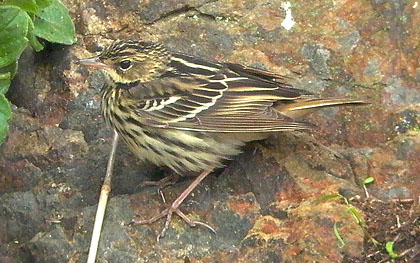
It appears to share many similarities with Individual One. It is rather dull, with off-white (and not white) "braces" contrasting with a largely blackish mantle, and it shows very strong rusty tones to the rump and uppertail. Of possible interest is the shape of the dark-markings on the upper tail coverts, rather diamond-shaped. On the closed wing, the blackish centred greater coverts have broad brown edges, reducing the strength of the contrast of the wing-bars. It also shows a fairly extensive but weakly buff wash on the underparts, fading rather paler towards the belly and the base of the legs. Interestingly, as with Individual One, the uppermost tertial shows a broad whitish or paler fringe, while the two lower tertials are more strongly fringed with rust. Although the bill appears stronger than e.g. the bill of Red-throated Pipit, it does not appear as strong as the bills shown by many later-migrating Pechora. Obvious differences from Individual One include the apparent darkness of the crown (partially a product of angle and the wet weather?), and the lack of obvious brown tips to several of the greater coverts. If the absence of such tips suggests a slightly more worn plumage, it is interesting to note that the underparts still remain obviously washed through with buff.
Following Svensson (1992), would it be appropriate to identify this as a menzbieri, based on its being "darker above and deeper yellow-buff below" than many nominate gustavi?
Individual Three, Seosan, May 30th 2004
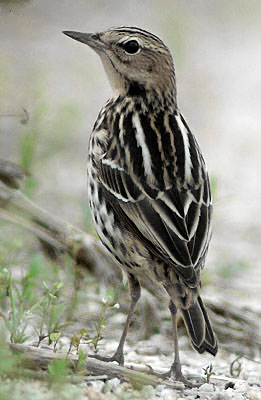
Same individual as in Fig. 7.
Individual Three was photographed at Seosan, in an area of very extensive rice-fields. Although possibly a result of individual variation, it appears strikingly different from Individuals One and Two, and very much more typical of most Pechora seen in Korea . Structurally, it appears very confident, with a more upright stance, a deep chest, and a rather strong bill, held slightly upward (suggestive of a ’large’ rather than a ’small’ pipit).
The upperparts are very contrasting, with clean white "braces" and warm-brown "tramlines", while the tertial fringes appear whitish, tinged faintly browner. The facial pattern looks rather more distinct than in either Individuals One or Two, with a warm-toned forehead, a clear but short and very thin moustachial stripe, and a broken malar stripe extending to a very densely marked malar patch. In addition, the eye-stripe (although very short in front of the eye) seems more prominent, contrasting with a stronger supercilium to the rear. There is also a diffusely darker spot at the rear of the ear coverts, forming the lower point of bi-colored ear coverts: paler, perhaps faintly grey-toned below and darker and warmer above, this warmth continuing uninterrupted to the gingery-brown patch on the nape sides. Although the nape shows some vaguely grayer-tones, this gingery patch is largely unmottled and clean looking, and is the warmest feature on the bird in typical posture.
Of further note, the rump and uppertail coverts, while appearing rusty-brown, are still less strongly saturated than in either individual one or two. The rump therefore appears very slightly paler than the central rusty "tramlines", and also less noticeable than the warm gingery wash on the nape sides, to the rear of the ear coverts. The visible dark centers to the uppertail coverts are arrowhead shaped or more diffuse. The outermost pair of tail feathers shows buff along its length (not whitish based, gradually becoming buff distally). Increasing the effect of contrast, the centers of the greater coverts appear blackish, and the tips white (though with brownish tips to the inner- and outermost).

Same individual as in Fig. 7.
The underparts also appear much whiter and cleaner than in Individuals One and Two, with only a faint buffy suffusion extending from the lower throat to the lower belly. The cleanness of the underparts means in part that there is an effect created of a rusty-brown wash extending from the rear of the tibia, unbroken and darkening up to the rear flanks, and moreover the streaks appear much blacker, sharper and more striking. Also of potential significance is the shape of some of the streaks on the breast sides, with some distinctly arrowhead-shaped.
On the brighter upperparts, and the cleaner underparts (lacking significant yellow-buff), as well as by date and structure, can this be safely claimed as a nominate gustavi?
Individuals in Autumn
Although several individuals have been seen (but not yet photographed) in early autumn with a very strong buffish wash on their underparts, the vast majority of later autumn Pechora appear rather similar to Individual 3. They share a similar posture, with strong bill held above the horizontal in sitting birds, with deep chests, and powerful legs.
Further similarities of late autumn Pechora include the sharpness, blackness and distinctiveness of the breast streaking, with some of the streaking showing arrowhead patterning on the breast sides; the lack of buff on the lower belly (with most of the underparts having a white or near-white background, contrasting with the buffish-washed upper breast); the ginger-buff patch on the nape sides appearing to be the warmest part of the bird in typical posture; and the better marked facial pattern.
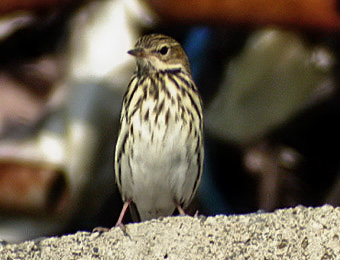

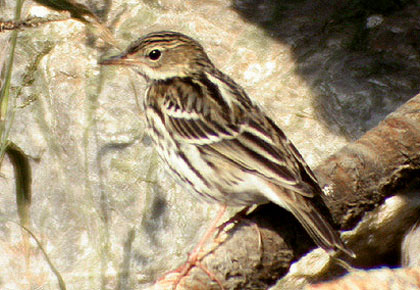
Facially, most show a rather stronger and longer eye-stripe than early autumn birds or Individuals One and Two; a weak submoustachial and a weak malar line, culminating in a fairly prominent malar patch. In some birds/images, the ear coverts also appear slightly two-toned, with a paler, grayer-toned lower half of the ear coverts offset by a darker, warmer upper half.
On most later migrants, the upperparts also appear very contrasting, with typically white or whitish "braces", and prominent white or whitish fringes to the tertials. From rear views the rump appears rather dull, and quite heavily mottled.
In many the rusty-brown wash from the lower flanks extends down in an unbroken wedge to the rear of the tibia: a feature also shown by Individual Three. There is also a warmer patch on the breast sides.
Vocalisations
Pechora Pipit in South Korea appear to give a slightly broader range of flight calls than described in most of the popular and specialist literature, including Alstrom and Mild (2003), with some earlier (and fewer later?) birds seeming to give calls strongly suggestive of eastern populations of Zitting Cisticola, and later birds with calls rather more suggestive of Grey Wagtail (and one of the calls of Red-throated Pipit).
The calls of Pechora have been described as "a short, sharp, clicking ’dzepp’ with almost electrical overtone repeated a few times" (Svensson and Grant, 1999), or as "a short, rather hard and slightly squeaky tsip, or differently transcribed, chip, which has an explosive quality. It is often rapidly repeated, e.g. tsi-sip; tsip-tsip-tsip; or tsi-tsi-tsi-tsip." (Alstrom and Mild, 2003). Such calls are the ones often compared to the flight call of Grey Wagtail. Although Alstrom and Mild (2003) state that " we have noted no difference in gustavi and menzbieri" flight calls, they add, "we have no good tape recordings of the former to make a more detailed analysis."
Allowing for the wide differences in methods of transcribing calls, there is a tendency in South Korea at least for early migrants in both spring and autumn to give "chit" calls in sustained flight that sound rather unlike Grey Wagtail, sometimes sounding more clicking: a thicker, "zuyt" or "chyut" (especially when gaining height?). The function of this Cisticola-like call (often repeated but with a clear pause between notes) is not clear, but perhaps is a variant of the typical sustained flight call or corresponds to a sharper loud "styet" or "styep" call given by at least one later-migrating individual (noted on May 30th). This latter call in turn resembled somewhat the "tsep" call sometimes given by Red-throated Pipit when in loose flocks (possibly an alarm call, given perhaps more frequently by migrants than suggested by Alstrom and Mild, 2003?). One further very well-observed ’early’ Pechora (with very brown upperparts and buff-washed underparts) also gave a shrill "ZuYT", presumably either due to accidental flushing or as a contact call (at least 3 others were present the same day, August 29th, in the same area). While earlier migrants tend to call with a thicker "u" sound, later migrants invariably give sharper, harsher calls, rarely with a harder "e" sound, or much more commonly based on a "Tit", "Pit" or "Zit", sometimes repeated as, "Pit Phwit Phwit", with either one or two tones.
Summary of Possible Features
Early- and late-migrating Pechora Pipit seem to exhibit a range of differences from each other, which might be useful to consider in the separation of menzbieri and gustavi in field conditions.
These differences are summarized below in Table 1.
| Points of Interest | Early Migrants: menzbieri | Later Migrants: gustavi |
| Spring Migration timing | Early: through South Korea in late April and early May | Late; largely through South Korea in the last third of May |
| Autumn Migration Timing | Early; largely through South Korea in late August and early September. | Later; through South Korea in late September and early October. |
| Structure | Suggests Red-throated Pipit. Appears smaller, less confident than ‘later’ birds; smaller-billed, and bill more often held at the horizontal. | Confident; bill often held above horizontal; suggests a ‘large’ pipit. |
| Plumage Contrast | Appears intermediate between ‘later’ Pechora and first-winter Red-throated Pipit, with more extensive buff wash to the underparts, and less contrasting upperparts. | Perhaps variable, but typically striking. Often appears very contrasting on the upperparts; buff wash largely confined to breast on underparts. |
| Warmest Plumage Tones | Rump | Nape and breast sides |
| Facial Pattern | Weak. Weak loral line; weak moustachial and malars (sometimes not at all apparent); ear coverts largely uniform, though slightly mottled. | Often slightly bicolored ear coverts, and sometimes a trace of a diffuse dark spot to the rear of the ear coverts; loral line a little stronger; moustachial stripe defined; malar defined, and malar “triangle” quite prominent. |
| Mantle | “Braces” diffused with buff or brown tones; black feathering extensive, but overall impression dull. | “Braces” often rather whitish or more typically white. Contrast very striking. |
| Tertials | Upper tertial palest, lower two tertials fringed more brown or rusty, with the pale extending along the inner edge. | Tertials rather white or whitish fringed; no obvious pale fringes on the inner edge. |
| Rump and uppertail coverts | Rusty-toned, marked with distinct but small diamond-shaped markings | Plainer rust-brown, with larger, longer and more diffuse dark centres |
| Breast sides | Some warmer brown suffusion on breast sides | Often warm brown suffusion on breast sides, similar to tones on nape |
| Underpart streaking | Black, very slightly diffuse-edged; background to streaks largely washed with buff | Black, very sharp and strong; often some streaking on breast sides forming arrowhead pattern, and longer lines on lower flanks |
| Rear of tibia/flanks | Rear of tibia dark rust. A diffuse area of rusty-brown extends down from the flanks towards the tibia, but is separated by an obviously paler patch. | Due largely to the cleaner background, warmer brown tones of lower flanks extends in a faint wedge unbroken towards the tibia. Rear of tibia dark brown. |
| Calls | Sometimes very suggestive of eastern Zitting Cisticola; “chip” notes and notes with thicker “u” sound. | Sometimes very suggestive of Grey Wagtail, “Chit” notes and very occasionally notes with a harder “e” sound. |
Conclusion
The publication of Pipits and Wagtails by Alstrom and Mild (2003) has both pushed back the frontiers of pipit identification and also greatly increased interest in the little known taxon menzbieri.
Their suggestion that gustavi and menzbieri perhaps should be split into two full species on the basis of differences in song, and perhaps also measurements, suggests that in the future a full review might be needed of all 'Pechora Pipit' records away from breeding areas. However, up to now there are no known and tested criteria for separating the two taxa in field conditions, and Alstrom and Mild add, "We have examined too few specimens of menzbieri to judge whether or not it is safely distinguishable from gustavi on morphological characters". Despite this, they observe that menzbieri should appear darker above than gustavi, and Svensson (1992) suggested a decade earlier that menzbieri should appear more "deeply yellow-buff below" than gustavi.
The specimen record in North Korea suggests that both menzbieri and gustavi probably occur in South Korea. Observations by the author of several hundred migrant Pechora Pipit in South Korea (most of them in flight, however) suggest that there are some possible differences apparent between early and late migrating Pechora.
Early migrating Pechora tend to appear rather smaller, less confident, and considerably duller than most later migrants.
They often show a rather extensive buff wash on the underparts, and a more deeply rufous or rusty-toned rump.
They lack a distinctive facial pattern when compared to later migrating Pechora.
Later migrant Pechora, by contrast, often show much more strongly marked upperparts, with a duller rump and the warmest colour on the bird concentrated on the nape and upper breast sides.
Facially, they often seem to show e.g. slightly bi-colored ear coverts, and a more apparent malar stripe than early migrants.
They lack much buff wash on the underparts, and their streaking is stronger, more distinct, and occasionally forms arrow-head shapes.
In addition, early migrants appear to give subtly different calls to later migrants.
Although all such observations are field-based, and lack the much-needed support of sonograms, measurements or proven origin of individuals described, they seem to suggest (1) the presence of both taxa in South Korea, and also (2) the possible existence of several criteria for separating these taxa in the field. All such features, however, are described in the complete understanding that they are all only possible features. Most (all?) of the suggested differences might simply be the product of individual variation, or even variation within little studied taxa.
Acknowledgements
Many thanks to Frederik Willemyns, Kim Dong Won and Park Ui-Soon (the latter through Kim Hyun-tae), for allowing use of their superb images.
Acknowledgement must also be given to the authors Per Alstrom and Krister Mild. While not yet contacted in connection with this note, their exhaustive research and attention to detail contained in their book have greatly clarified plumage details and suggested migration strategies, greatly increasing interest in the little known "Menzbier's Pipit".
References:
- Alstrom P, & K. Mild (2003). Pipits and Wagtails of Europe, Asia and North America, Identification and Systematics. Christopher Helm, London.
- Dierschke, J & F. Heintzenberg (1994). Happy Island and Beidaihe Bird Report. 28/08/1004- 28/9/1994. (produced privately).
- Tomek T. (2002). The birds of North Korea. Passeriformes. Acta zool. Cracov. 45 (1): 1-235.
- Svensson L. (1992). Identification Guide to European Passerines. 4th Edition.
- Svensson L., & P. Grant et al (1999). Collins Bird Guide. HarperCollins Publishers.



